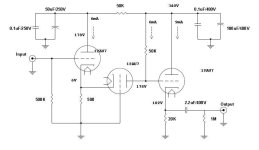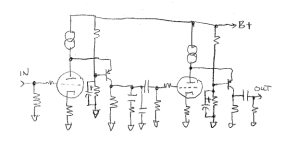I'm tinkering with the concept of putting together a passively equalized RIAA vacuum-state preamp using folded cascode gain cells. I'm doing my current design using 8CG7. That's a nice, linear tube but not likely the best noise-wise. I am open to suggestions for alternate tube types to use in the design. The design would incorporate a 40X input stage, EQ, then a 30X output stage, which gets you ~40dB of gain at 1kHz, good for MM cartridges.
I'm toying with the idea of using 6AM4, a tube championed by Vinylsavor at his blog site. However, given that the transconductonce of that tube is much higher than the 8CG7, I will end up with a load resistor on the lowish side for the gains I'm contemplating, and consequently some fairly bloated values for the EQ capacitors - maybe not a real problem, but still a consideration. Thoughts?
I'm toying with the idea of using 6AM4, a tube championed by Vinylsavor at his blog site. However, given that the transconductonce of that tube is much higher than the 8CG7, I will end up with a load resistor on the lowish side for the gains I'm contemplating, and consequently some fairly bloated values for the EQ capacitors - maybe not a real problem, but still a consideration. Thoughts?
In solid state designs, "folded cascode" means gender-1 transistor collectors connected to gender-2 transistor emitters, where gender-1 and gender-2 are not the same.
What is "folded cascode" in the vacuum tube world?
What is "folded cascode" in the vacuum tube world?
Folded cascode with a vacuum tube as contemplated would be a triode fed by an appropriate current source at the plate (maybe resistor, maybe solid state) with a PNP output transistor providing the usual cascode load and level shift. EQ would be applied across the first stage load resistor. So, it's a hybrid solution with some sand to help out the vacuum state elements.
In another universe, I guess one could contemplate p-style tubes that used positrons instead of electrons, but not in this particular plane of existence...
In another universe, I guess one could contemplate p-style tubes that used positrons instead of electrons, but not in this particular plane of existence...
I may also consider a stealth favorite of mine, the 6JK8. There is a 17V filament option that I could feed using a standard 19V adapter plus dropper resistor (likely also with some capacitive filtering). I think I got a mess of them from Stan's $1 list before his passing - I'll have to check and see.
If the first stage load resistor is too small, just add a series resistor of a more appropriate value going to the RIAA network,I'm toying with the idea of using 6AM4, a tube championed by Vinylsavor at his blog site. However, given that the transconductonce of that tube is much higher than the 8CG7, I will end up with a load resistor on the lowish side for the gains I'm contemplating, and consequently some fairly bloated values for the EQ capacitors - maybe not a real problem, but still a consideration.
and recalculate the values with the now higher output impedance.
Last edited:
Two tube sections could be arranged in a differential look-alike arrangement, but with the plate of the first tube section connected directly to the positive power rail, and its cathode used to feed the cathode of the second tube section (IOW first tube section becomes an input buffer).
Grounding the grid of the second tube section will make it serve as a cascode for the first tube, with voltage gain achieved by inserting loading between the plate and positive power rail (of the second tube).
Not quite a folded cascode, but not completely dissimilar, either 😉.
Grounding the grid of the second tube section will make it serve as a cascode for the first tube, with voltage gain achieved by inserting loading between the plate and positive power rail (of the second tube).
Not quite a folded cascode, but not completely dissimilar, either 😉.
Current sources can be noisy, especially in that location. You'll have to tweak the DC conditions to
share the current properly between the tube and PNP.
If the Rcollector is too small for reasonable RIAA values, add a series resistor between the collector
and the RIAA network to increase the output impedance, and recalculate the values.
Try to get the total output impedance seen by the RIAA network to equal 750k.
Then you will have 1nF and 2.92nF for the capacitor values.
share the current properly between the tube and PNP.
If the Rcollector is too small for reasonable RIAA values, add a series resistor between the collector
and the RIAA network to increase the output impedance, and recalculate the values.
Try to get the total output impedance seen by the RIAA network to equal 750k.
Then you will have 1nF and 2.92nF for the capacitor values.
Last edited:
I am OK with tweaking the current source for optimum voltage across the cascode load resistor - not a biggie. A ring of two current source using KSA992 may be the deal for low noise operation. I may also use a low-noise fet with series resistor to bias the ring-of two instead of just a simple resistor, or split the resistor and bypass it. This preamp is for MM cartridges after all, and I have seen all sorts of games played in that realm. I figure I can easily beat the usual high-impedance 12AX7 setup.
I have my own favorite values for RIAA cap setups - one is 100 nF and 34 nF (the last is either precise 33nF + 1nF or selected 33nF). I use that mostly with sand-state RIAA preamps, though I did also use it with a hybrid setup using the 6N3P-EV, as the gain cells had low output impedance due to negative feedback. Another one of my faves is 22nF and 7.5 nF. That combo is one that I would consider for a vacuum-state preamp.
Last edited:
There's a yeah-but associated with that. I also have to consider the bleed resistor on the second stage grid in my calculations. I'm curious about the actual output impedance of the cascode PNP transistor. I figure what I'll do is set up a gain cell in PSpice and hit the output of the cascode with a modulated current source to see what amplitude of disturbance is generated. That will at least get me a rough estimate.
I just ran the sim with 10k load at the cascode collector and 0.0001A excitation, and the impedance of the cascode collector appears very large, as there appears to be no difference in the signal amplitude from that presented by a pure 10k resistor. I'll take that into account when I'm selecting my RIAA reesistor values
Another possibility would be to split the passive EQ, putting the HF EQ section on the first stage and the LF roll-off on stage 2. That might make sense if I end up using the 6JK8, as it has one very high transconductance triode that would be a natural for first stage duty, and a lower transconductance triode that would be good for the second stage.
- Home
- Source & Line
- Analogue Source
- Folded Cascode RIAA Tube Preamp

